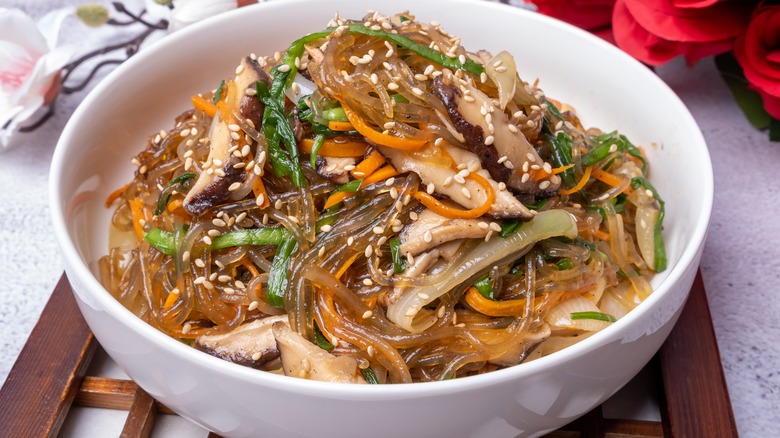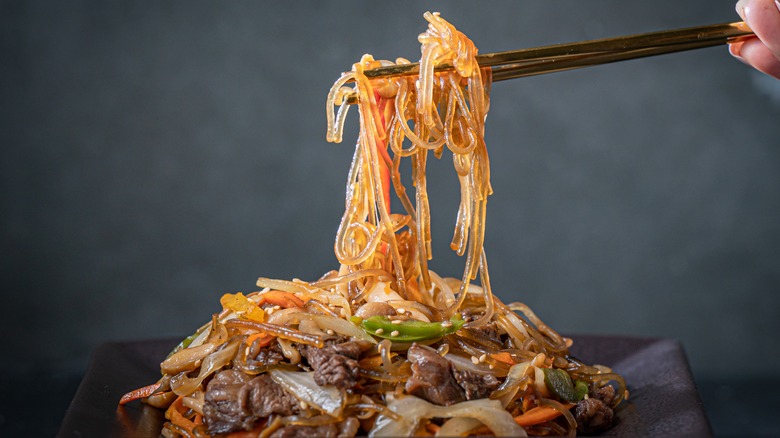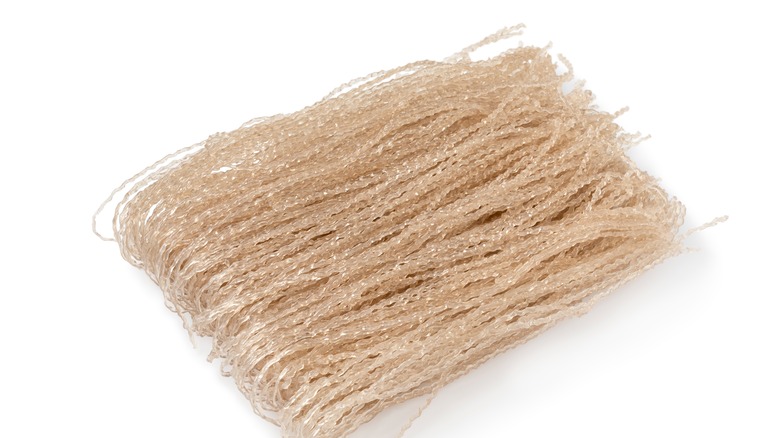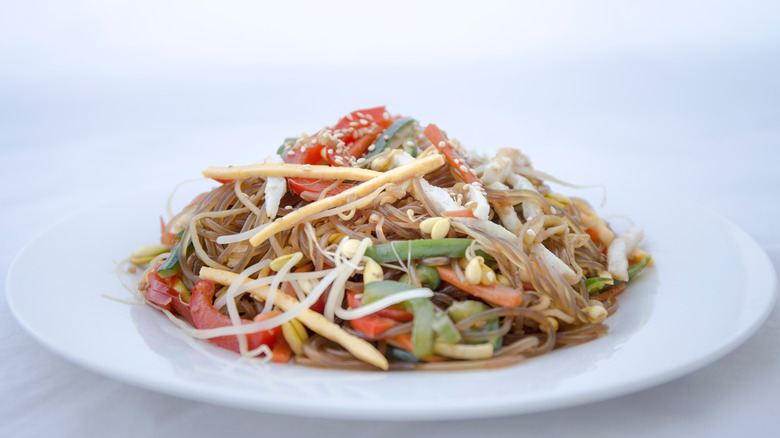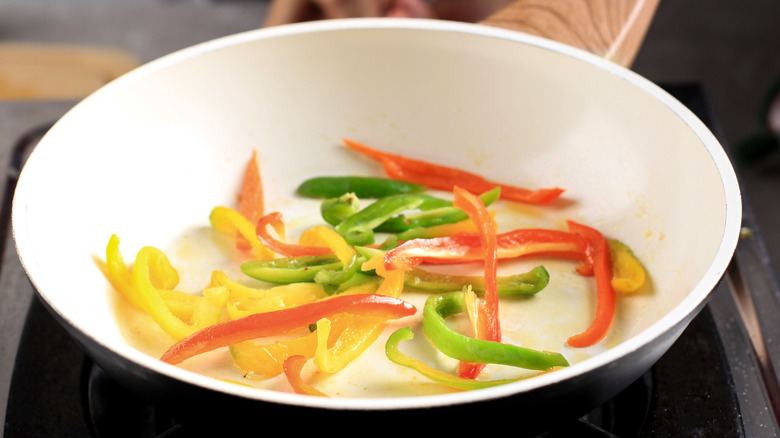Japchae: The Stir-Fry Noodle Dish That's A Korean Favorite
While delicious japchae is commonly prepared for holidays and special gatherings, the Korean version of a stir-fry is enjoyed throughout the year and is often one of the first dishes non-Koreans try of the country's food. The classic dish consists of noodles, meat, and vegetables. And like so many Korean recipes, its spiciness is based on an individual's taste.
Japchae, according to Korean Bapsang, means mixed vegetables, of which there are plenty in this dish. But, the heart of the recipe is the glass noodles, which when cooked properly are a little springy, yet soft, and with a slightly sweet taste. Surprisingly, according to Kimchi Mari, the noodles that the dish is now famous for weren't always part of the recipe. When japchae was first made in the 17th century, it was created for King Kwanghaekun during the Joseon Dynasty and it lacked noodles. It wasn't until two centuries later that noodles became a component of the dish after a glass noodle factory opened in northern Korean in 1919.
Ever since then, noodles have been the base of japchae which should have well-balanced flavors and textures. It should be both sweet and savory, as well as have slightly firm vegetables that offsets the soft, but not mushy, noodles, advises My Korean Kitchen.
How japchae is served
While japchae is easy enough to be made any day of the year, it's a common dish for holidays, such as New Year's and Harvest Festival, says My Korean Kitchen. Most often served as a side dish, japchae also works well as an appetizer, says Kimchi Mari, even frequently making appearances at potlucks. Another time that japchae is commonly served is when people are introduced to Korean food for the first time, says Kimchi Mari, because of its mild flavor.
If you are taking a bowl of japchae to a potluck and it gets cold on the way there, that's OK because the dish can be served hot or cold, per My Korean Kitchen. However, if you still want it warm, it can be reheated in the microwave, but Kimchi Mari says reheating japchae in a pan on the stovetop produces the best results. If preparing ahead of time, or storing leftovers, japchae can be kept in the fridge for 1 to 2 days in an airtight container. Any longer and the noodles start to lose their texture. In Kimchi Mari's opinion, japchae tastes best at room temperature.
Don't skip glass noodles and fresh vegetables
A variety of ingredients comprise japchae, but it must always begin with springy glass noodles, also known as Korean sweet potato starch noodles or dangmyeon, per Korean Bapsang. When eating japchae, the diner is most likely to find a mix of carrots, spinach, mushrooms, onions, and scallions, while chili peppers, bell peppers, garlic chives, and cucumbers are other popular additions. Specifically for mushrooms, shiitake and wood ear mushrooms are preferred, but if they are not available, Korean Bapsang recommends using oyster mushrooms. Maangchi chooses to use dried shiitake mushrooms that have been reconstituted with warm water, as well as white mushrooms.
Meat added to the noodles are typically thinly sliced beef or pork, says Korean Bapsang. Specifically, Maangchi opts for filet mignon or pork shoulder, while My Korean Kitchen recommends using rib eye fillet that is cut into strips. Another ingredient that Maangchi adds to her noodle dish is a cooked egg garnish called jidan. Most recipes say this is an optional addition. The yolk and white are cooked in a pan with a little oil to form a thin disk. Other garnishes can be sesame seeds and sesame oil.
Japchae variations
Two japchae variations that Korean Bapsang highlights are a soybean sprout japchae, called Kongnamul Japchae in Korean, which is a vegetarian version of the noodle dish. Its two main ingredients are soybean sprouts and sweet potato starch noodles. Another kind of japchae that Korean Bapsang shares is a recipe made with seafood (shrimp and calamari) that is given plenty of spice with gochugaru (Korean red chili pepper flakes). The classic Korean condiment, gochujang, is another option for adding a little heat to the dish.
A vegan take on the noodle dish can be done easily by swapping the meat for more mushrooms or tofu, says Korean Bapsang. Any kind of vegetables and greens can be used to make japchae if they can be stir-fried, according to Gimme Some Oven, which also recommends using a non-Korean ingredient for the stir-fry sauce: maple syrup. New York Times food writer Eric Kim puts his own take on the Korean dish in his cookbook, as reported by East Bay Times, that directs the cook to bake the noodles on a pan sheet that has already been roasting mushrooms, scallions, and sauce.
How to make japchae
While a lot of noodles should be cooked until they are al dente, Korean Bapsang cautions against this with the glass noodles for japchae, which should be cooked until they are soft and springy. How long they are cooked in boiling water varies by brand, but typically it takes about 8 minutes. After they are drained and rinsed with cold water, Korean Bapsang adds the sauce to the noodles and then pan fries them.
Preparing the vegetables for japchae takes a little time. In addition to cutting them, they are also cooked separately and added to the sauced noodles at the end, per Korean Bapsang. Don't try to save time by stir-frying the vegetables together because each one requires a different cooking time, advises Maangchi, and by doing so you could end up with unevenly cooked vegetables. By stir-frying the different types of vegetables individually and with care, they maintain their color and crispness. Also, before cooking the meat and shiitake mushrooms, Maangchi marinates them in a bowl with minced garlic, sugar, ground pepper, soy sauce, and sesame oil.
The sauce used for japchae has a little sweetness and a little umami flavor with its ingredients of brown sugar and soy sauce. Other ingredients include sesame oil, minced garlic, sesame seeds and black pepper, per Korean Bapsang. My Korean Kitchen's marinade for the noodles and mushrooms calls for honey for a little sweetness.
